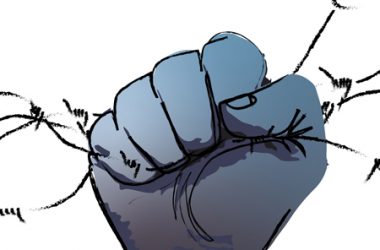By Amelia Frank-Vitale
Antipode
December 2020
Siobhán McGuirk and Adrienne Pine (eds), Asylum for Sale: Profit and Protest in the Migration Industry, Oakland: PM Press/Kairos, 2020. ISBN: 9781629637822 (paper); ISBN: 9781629637822 (ebook)The final page of “A Guard’s Story” – a chapter in the style of a graphic novel – shows the disembodied faces of two asylum seekers peering down at the former guard, looming over him wherever he goes. Their expressions are emotionless, inscrutable; the guard looks haggard, haunted.
This page stayed with me after closing Asylum for Sale, much in the same way that the stories of asylum seekers with whom I have worked linger long after an asylum officer or judge has decided their fate. And this effect is one of the powerful features of the book. Asylum for Sale is an academic book with a clear argument and an important place in the literature, but it is also, at once, an analysis of the conditions of asylum and detention that comes directly from those who are subjected to its violence. Their stories loom over the reader, loom over the other authors throughout the text, reminding us that the scholarly treatment of this system should nevererase the people who live it and, unsettlingly, that those of us who do write about asylum seekersalso participate in and benefit from the same asylum industry that this book, as a collection, unmasks and condemns.
The argument of Asylum for Sale is big and bold: treating asylum as an industry, as a regime, rather than as an exception to the other industrial complexes with which migrants are entangled. It isn’t an argument that builds from chapter to chapter but, rather, is stark and plain. Each chapter contributes to the argument, to be sure, but it is stated and treated as fact, not theoryto be proven. Each chapter, then, is a piece of evidence, a moment, a vignette, a reflection, that demonstrates how, over and over again, asylum itself is less about saving lives than about profiting off the elusive promise – which is almost never fulfilled – of the possibility of life being saved.1
Editors Siobhán McGuirk and Adrienne Pine make clear in their introduction that the volume doesn’t require reading the chapters in order. “Readers are encouraged to move between them as they choose, following cross-references or pursuing their own lines of interest” (p.12). The unnumbered chapters are grouped into five loosely coherent thematic sections; it is an ordering which has a logic, but the chapters could have been reshuffled in a variety of ways and told the same story. The project as a whole is so broad as to be just a touch unwieldy. There are afew chapters that could have been left out, and one or two that felt out of touch with the rest of the volume. (Garry Leech’s chapter seemed particularly out of step, like a text from 20 years ago, even though it discusses the USCMA that updated NAFTA.) Some of the chapters get repetitive, while the breadth of contributors – from journalists, to academics, to social workers, direct action activists, organizers, and detainees, and asylum seekers themselves – makes for an unevenness in the writing. This is, perhaps, an unavoidable challenge for a collection that is insistently cross- and beyond disciplinary. And ultimately the strength of the book is as a collection, in the way it shows parallels across the globe, as profit is made off those seeking refuge in both large-scale and small, subtle, everyday ways. This is one of the most powerful aspects of Asylum for Sale; how the editors reveal processes that are common around the world while also including the particular details of each specific situation. This isn’t simply about the US border regime, or Fortress Europe, or the island waiting rooms of Australia. McGuirk and Pine have pulled together a collection that fully unveils how asylum itself, how it is managed andoperated, as an international norm, is really an industry.
Their argument is situated firmly in a neoliberal moment “with increasingly fascist hues” (p.9), although they draw a clear line from an already racialized system of international protection in the post-World War II area through to the present day. Sometimes neoliberalism has been reduced to a buzzword, emptied of specificity. This is not a book that does that. Here, neoliberalism means something very specific. As Seth Holmes writes in his foreword, “[n]eoliberal capitalism is here defined both as the political economic system of privatization of 2
public goods and the symbolic system of the privatization of risk and responsibility” (p.xi). This clear understanding of neoliberalism (with increasingly fascist hues) is one thread that ties together the array of contributions to this volume and forms the foundation of the argument that asylum is a product up for sale and an industry whose very existence rests upon the fact that people can make a profit off it.
There are three other threads that I want to tease out that crosscut the chapters, before I highlight a few specific contributions. First, a crucial intervention of the collection is to show how “bogus” asylum seekers are produced through the asylum industry. By definition those who give up or fail at claiming asylum must be bogus, and this is used to justify an increasingly carceral approach to dealing with those seeking refuge, in the name of “weeding out” those “bogus” claimants. It is a circular logic that feeds into the profit making of the system, putting public resources into private companies to “manage” a population that will mostly not be grantedasylum – in the name of protecting public resources from those who would try to “game” the system to take advantage of supposedly generous social welfare. The three major cases – Australia, the EU, and the US and Canada – all have this feature embedded into their asylum regimes. Related to this, is the way in which the marketization of services – even if that provision is literally imprisonment and being fed while imprisoned – lowers the quality of the services while at the same time allowing the state to claim “taking care” of those who are in the process of seeking protection.
This shows a system that pushes people to the edge, dehumanizes them, makes a profit off them, and, if they fail or eventually give up, blames them for that failure and uses that to justify increasingly more expensive and less humanitarian approaches to “managing” asylum seekers. The second thread is related to this, as the entire volume paints a devastating picture of the way in which suffering itself is commodified in the asylum industry. Being able to prove a certain kind of suffering becomes one of the only ways to access mobility for many people across the globe, so claimants are expected to be able to produce harrowing narratives of pain 3
and trauma, on demand, in a certain register, to elicit empathy, pity, and to access “salvation”. Here, NGOs, non-profits, and international humanitarian organizations like the Red Cross and UNHCR, are implicated as they participate in reifying what Adrienne Pine calls a “hierarchy of legally legitimate suffering” (p.206). This makes those asylum seekers who are unable to “prove” their trauma in a way that is legible to those who appraise it responsible for their own failure to access safety.
The third thread that I think is important to highlight is the emphasis the editors clearly place on not just identifying and analyzing all the ways in which the asylum system revolves around profit motives but also attending to the ways in which asylum seekers themselves and their allies resist. Most of the chapters focus on some aspect of a system which is enormous and would seem to almost foreclose the possibility of fighting it – especially as it holds out a slim possibility of “winning” for a few asylum seekers. Yet this is not the argument the book is making; while including accounts of detainees and those who have grappled with the asylum system from the inside, almost every chapter ends with a discussion of protest, resistance, and agency. Asylum for Sale is a wholesale indictment of the supposedly humanitarian system of international protection, yet it retains a spirit of optimism at the potential for migrants and refugees everywhere to challenge and remake the world.
In addition to the compelling and reflexive chapters authored by each of the editors (and the always engrossing writing of anthropologist Nancy Scheper-Hughes and journalist Todd Miller) there are two chapters which stand out and need to be read widely. First, organiser and researcher Marzena Zukowska’s “The Cost of Freedom” is a powerful critique of “alternatives todetention” in the US – like releasing asylum seekers on bond or using ankle monitoring.
Understanding these practices not as alternatives but as extensions of detention, she shows first the huge profits being made and the human toll they take. While there is wide awareness of the problems with private prison contracts in the United States, the ways in which this bleeds into 4
controlling the lives of those released from detention deserves much more attention, and Zukowska’s chapter is an essential starting point.
Similarly, anthropologist Julia Morris’ “Making a Refugee Market in the Republic of Nauru” expertly links the island nation’s export economy with its “importation” of Australia’s refugees as a shift from one dominant industry to another. She also highlights the multi-million dollar industry in humanitarianism that accompanies the violent offshoring of refugees here, as an entire infrastructure is built by Australia to “serve” the refugees who become imprisoned on an island that is happy to take the budget their presence offers, but is less hospitable to the actual refugees.
Unusual for an academic text, the book also includes the first person account of a failed Honduran asylum seeker, excerpts from the Detained Voices project (https://detainedvoices.com/), the drawn reflections of a former camp guard (who is haunted by the images of some of the detainees), photo essays, and paintings. The editors walk a fine line with the kinds of texts and accounts that they include, clearly wanting to allow people to speak for themselves while also diligently avoiding reproducing the kind of narratives of suffering that they rightly critique as being commodified within the asylum industry.
Ultimately, Asylum for Sale is an important contribution to the study of the migration regime, deflating any lingering notion that the system of international protection operates on higher moral ground than the parallel systems of migration management. It is a text I will return to again and again to cite, and it includes more than a few chapters that I will assign in my own classes on migration, borders, and legal violence. Perhaps most importantly, however, Asylum for Sale is essential reading for those of us who participate in the asylum industry as experts and advocates, a call to take a critical look at our own complicity in a system that, essentially, appraises trauma and adjudicates both the moral and economic worth of human lives.
Siobhan McGuirk – In addition to her academic publications addressing gender and sexuality, migration, and social justice movements, McGuirk is an award-winning filmmaker, curator and editor for Red Pepper magazine. Her writing has appeared in Teen Vogue, Rewire News, and Australian Options. She received her Doctorate in Anthropology from American University in 2016 and holds a Masters in Visual Anthropology from the University of Manchester. She is a Postdoctoral Researcher in Anthropology at Goldsmiths, University of London.
Adrienne Pine is a critical medical anthropologist whose work has explored the embodiment of structural violence and imperialism in Honduras, cross-cultural approaches to revolutionary nursing, and neoliberal fascism. She has served as an expert country conditions witness in around 100 asylum cases over the past fifteen years. Adrienne is an assistant professor at the American University and author of Working Hard, Drinking Hard: On Violence and Survival in Honduras.
Check out Adrienne Pine and Siobhán McGuirk’s & new book:




